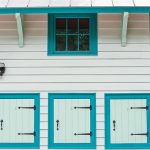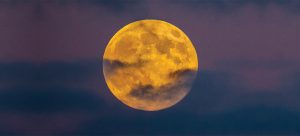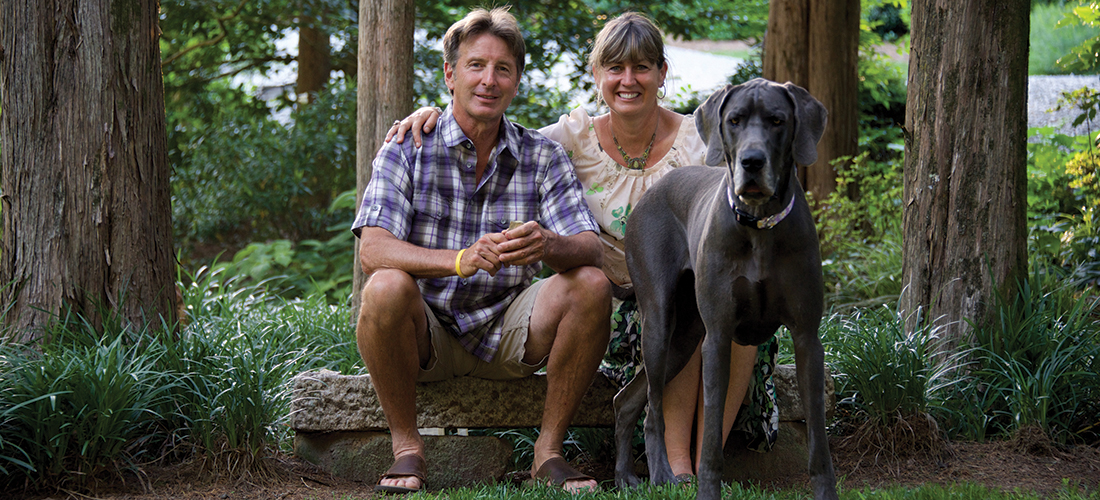
For Cindy Jones and Craig Wagoner, 19 years was just enough time to produce a magical garden shaped by imagination and spirit
By Ross Howell Jr. • Photographs by Lynn Donovan
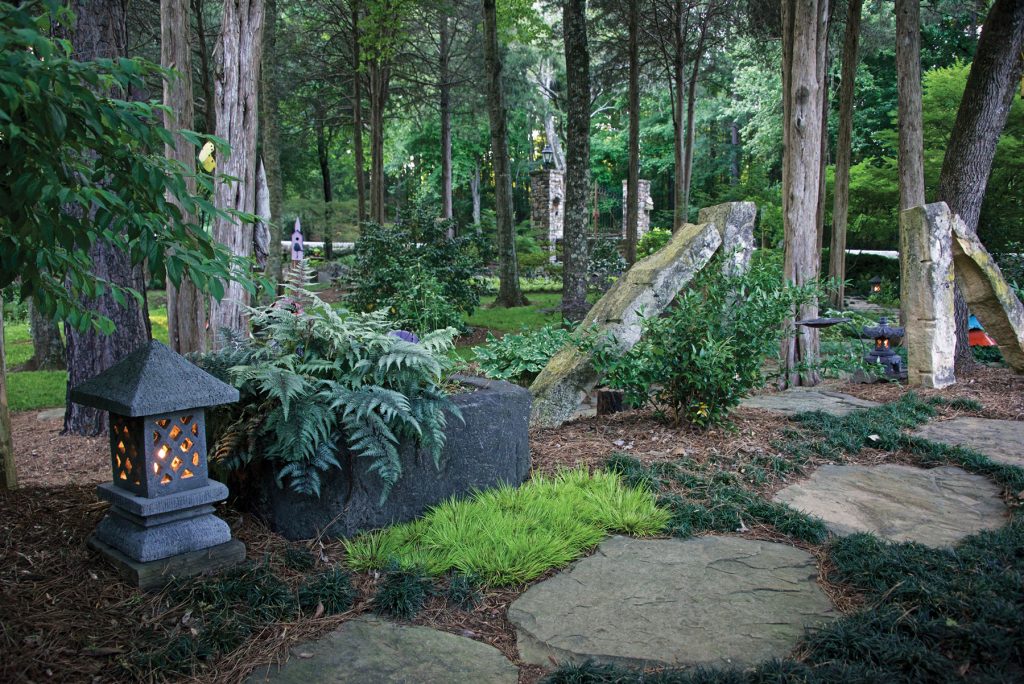
On a macadam road outside Greensboro, my wife, Mary Leigh, and I pass small farms with pastures bordered by tidy, four-board fences. Horses lift their heads from grazing to watch us go by, flicking their tails. Barn swallows dip and swerve over hayfields. We pass tree groves, creek bottoms and modest houses with wide expanses of lawn. A lady wearing a straw bonnet waves at us from her riding mower.
We turn onto another road and slow when we see the address on a mailbox. Tires crunch on gravel as we turn into the drive. Before us stands a glade. Several hardwoods. The drive begins a gentle descent. Then we see the entrance.
Boulders stand by the road, as though they’d been deposited by a glacier, and before us rise impressive stone gate guards. Beyond, I see something I haven’t seen since I lived in the Midwest. Limestone fence posts.
The gravel drive winds past a pond, past scattered Japanese maples, magnolia trees, more boulders before starting to rise. Atop a knoll stands a handsome house with a big front porch. Walking toward us from the other side of the drive is a trim man, suntanned, a touch of gray in his hair. He’s carrying a watering can.
That’s Craig Wagoner. He puts the can by a spigot and greets us as we get out of the car. The front door of the house opens. Cindy Jones calls hello and invites us inside. She is suntanned, too, trim as Craig, her smile as bright and friendly as her invitation.
A female Great Dane, her coat so dark a gray she looks blue, gallops by Cindy’s knee and trots down the porch steps.
“That’s Daphne,” Cindy says. “She’s friendly.” The Dane snuffles my hand, moves on to Mary Leigh, then surveys the slope in front of the house.
“Really helps with the deer,” Craig says. “Here, come on in.”
We sit in the living room under a high ceiling, the wide stone fireplace rising to the peak of the roof. There are metal sculptures on the walls. Through the back windows I can see sweet corn just beginning to tassel, the tops of tomato plants bright with yellow blossoms.
There’s a rustling in the flue.
“Chimney swifts,” Craig says, grinning as he shakes his head. “Every summer. We’re definitely in the country here.”
I feel calm, though I’m with strangers, as though the place I’m sitting was prepared for me starting a long time ago.
Turns out, it was. Starting nineteen years ago, to be specific.
Craig purchased this 6-acre parcel in 1997. After a career in finance and insurance, he was in a position to act on a dream.
“I always wanted to live in a park,” he says. “I was born and raised in Kansas — on farms. We had livestock and my parents grew vegetables. It seemed like I was always outside, exploring, and Nature just spoke to me somehow.” He nods his head, musing.
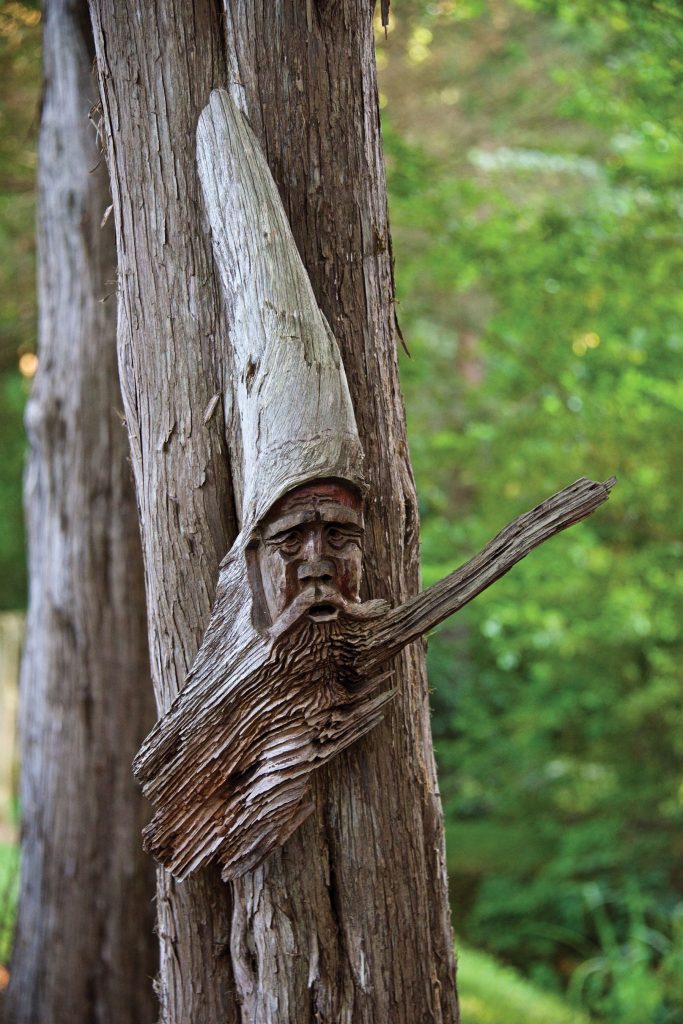
“This land was part of the Carter farm,” he continues. “They were an old Virginia family from Richmond. The place was so overgrown with brush and vines I couldn’t even walk through. So I started clearing.”
About that time, Cindy Jones moved to North Carolina to continue her career in leadership development.
“When we met, I think Craig was surprised I was as passionate about gardening as he was,” she says. I hear her Canadian accent in the word, “about.” Cindy grew up in Montreal, where the growing seasons are short and the winters fierce.
“Everyone in our neighborhood was a gardener,” she says. “As soon as the weather began to warm, people were outside, working in their vegetables and flowers. Both my parents were devoted to it. And I loved being outside with them. In fact, that’s how I was punished if I misbehaved. I had to stay inside the house.”
“People in my Montreal neighborhood had big gardens, with only a little bit of grass,” she says. “It surprised me when I moved to North Carolina, where we have a long growing season and temperate climate, ideal for all sorts of plants, yet everyone seems to want a big yard to mow!”
As Craig began to clear brush and vines, thinking about where he might locate the gardens and house, he discovered that the Civilian Conservation Corps had built six earthen terraces on the land.
“I don’t know why,” he says. “We’re on a knoll here, not far from the Haw River. Maybe topography had something to do with it. Anyway, we had to take the terraces into account when we started planning the gardens. Want to have a look?”
We walk along the gravel drive over a gentle rise. I see more limestone fence posts by the drive. Cindy tells me there are more than sixty of them on the property. Below us the drive makes a turnabout, with massive stones arranged in a concentric ring.
“These are the Standing Stones,” Craig says. “Thirteen boulders, Tennessee stone, for the thirteen full phases of the moon in a year. Good place to meditate.”
Beyond the ring of stones are other boulders, and here and there, stone fence posts. Nearby, a big stone sculpture of Buddha rests on a wooden pallet.
“Haven’t got him where he’s supposed to be,” Craig says. “See the top of that big pine up the hill? He’ll go up there, for a Buddha Garden.”
“Definitely a work in progress,” Cindy says. “The whole place. There’s something new, something different, every year.”
Past the circle of stones, Craig points up the slope.
“See the dragon bridge? The dragon is a Buddhist protector. Good luck in a garden.”
From my vantage, I now see the pattern of rocks depicting the creature’s back, with a broad stone for its head.
“I’ve always been interested in stone,” Craig says. “But I got more and more interested in how the Japanese use it when I started on the gardens here. It’s said that walking barefoot on stone will help forestall the onset of dementia.”
He looks about. “The limestone fence posts we trucked in from Kansas. Blue stone from Pennsylvania. North Carolina stone from old gristmills. Stone from all over. See? Those small millstones are from China.”
Craig pauses. “And there’s the contrast of stone with living things. The Japanese see stone as the passive element of a garden. Plants are the active, vigorous element. So that led to my interest in Japanese maples. They’re so hardy, we started planting them all over the property.”
“Because meditation is essential to the design of Japanese gardens,” he continues, “Cindy and I started thinking of our gardens as destinations. They would be places where people could go to meditate.”
We leave the Standing Stones and approach a grassy open area at the edge of a wood. I see pits for pitching horseshoes.
“There’s a stone path from here that leads down to a pond,” Craig says. “In this open space, we can put up picnic tables, maybe a badminton set, for cookouts.”
“How is it everything is so well-kept? The beds, the lawns, everything?” I ask.
“Cindy and I have done all the new plantings here,” Craig says. “All of them. But Cindy and I operate the Edgefield Plant and Stone Center. It’s a great way for us to make a living, get plant materials at good prices and have help maintaining the gardens. So once a week I come in with a crew of three. We mow and tend all the beds, so everything gets done right.”
“Even with help,” Cindy says, “Craig and I work out here every evening, every weekend. It’s what we love.”
We walk up the hill, closer to the house. The shape of one of the old CCC earthen terraces comes into view. There are teak benches near a big field of boulders planted with flowers and perennials.
“The Boulder Garden,” Craig says. I take a seat on one of the benches, its seat and back cut from a massive teak log. It’s incredibly comfortable. Bees drone in the flowers. The breeze freshens.
Nearby is a bowl cut in the earth, almost perfectly circular, filled with tall grasses and cattails.
“That’s the Frog Pond,” Craig says. By it stands the statue of a goddess. Craig follows my eye to the stone figure.
“The pond was supposed to be a formal fountain,” Craig says. “My plan was to build the house here, by the fountain.”
“We debated about where to build for five years,” Cindy says. Her eyes twinkle.
“I guess you can tell who won,” Craig says. He grins sheepishly at Cindy. “Anyway, the frogs enjoy it. You should hear them in the spring.”
We approach a green farm gate near the house. I get a good view of the vegetable garden I’d first noticed through the back windows of the house. We pass through the gate. There are flowers and hostas planted here, and pretty birdhouses and feeders. Mary Leigh remarks on a small headstone among the flowers.
“Our Emma and Lily Garden,” Cindy says. “Two of our pets are buried here.”
There are a variety of conifers where we’re walking now. We’re in the Pines destination, and most are native to the region. The contrast of their color, size, bark and foliage is fascinating. Various Japanese maples are scattered among them. Craig stoops and brushes the needles of a low-growing conifer the size and shape of a basketball.
“This little guy? A native of Hungary,” he says. “It’s a mature plant. Only grows about an inch a year. We’ve planted a real hodgepodge.”
“We have more than seventy types of Japanese maple, somewhere in the twenties for different types of pine and more than twenty types of cryptomeria,” Cindy says.
“There’s no irrigation, and we like to grow organically, so what we plant has to be hardy and sustainable,” Craig says. “All the magnolias, for example, are native species.”
A cardinal perches atop one of the pines.
“We see remarkable bird migrations,” Craig says. “You know rose-breasted grosbeaks, how pretty they are? One evening there must have been 200 of them in a flock. Right here. It was unbelievable. So we take into account the birds when we do our planting. And, of course, the deer. They bed down by the Frog Pond all the time. So we put up stakes to make sure bucks rubbing their antlers won’t girdle a new tree.”
We stop by a large bush, 15–20 feet tall.
“Witch hazel,” Cindy says. “There are tiny white fruits at the base of the leaves as early as February. They have this delicate cinnamon scent. The bush comes into full bloom in the fall. We planted it next to our daughter’s bedroom window because she loves the fragrance.”
As we top the brow of the hill on the entrance side of the house, we see an aerated pond below us, in the dell. Near it are big willow oaks, cryptomeria, Japanese maples, hostas, stone pathways. As we approach, I spy a small metal sculpture with wings next to a wooden bench. By the tiny creek feeding the pond, I see another winged figure fashioned in glass. There are gnomes carved in wood and whimsically painted birdhouses.
“The Pond and Fairy Garden,” Craig says. “Cindy’s creation. There are all sorts of turtles in the pond. I can scatter some pellets, if you want to see them feed?”
I shake my head, “No.” I’m enjoying the quietude.
Craig points out a couple of Japanese maples.
“These are pretty unusual,” he said. “This is Acer griseum, paperback maple, and here, Acer circinatum, vine maple.”
A few more steps along the stone path we arrive at our last destination, the Swings at Willow Oak Tree. It’s cool here in the shade, not far from the pond. Tranquil. My wife, Mary Leigh, flies, arms and legs akimbo, in one of the swings Craig has suspended by thick ropes from the limb of an oak. She smiles and smiles, like a little girl. Cindy and I are sitting on a wooden bench, watching. The sensation that came over me in Cindy’s and Craig’s house returns. I feel I’m sitting in a place prepared for me — for us — over a long period of time. Nineteen years, to be specific.
The shadows in the woods deepen. The plash of water in the pond is gentle, soothing. I hear a towhee call from the trees across the gravel drive.
I look at Craig, who’s sitting on another bench. We smile at each other.
“People always like the swings,” Craig says. “I tell them, ‘Breathe deep, and be free.’” OH
Ross Howell Jr. lives “on the artsy side” of Fisher Park, Greensboro, with his wife, Mary Leigh, a public relations professional specializing in home and garden; a geriatric English cocker spaniel, Pinot; and two rescued pit bulls, Sam and Elly.

